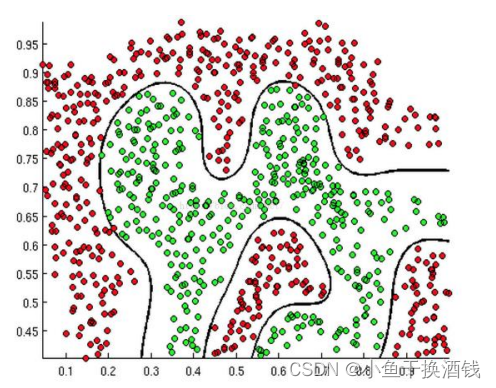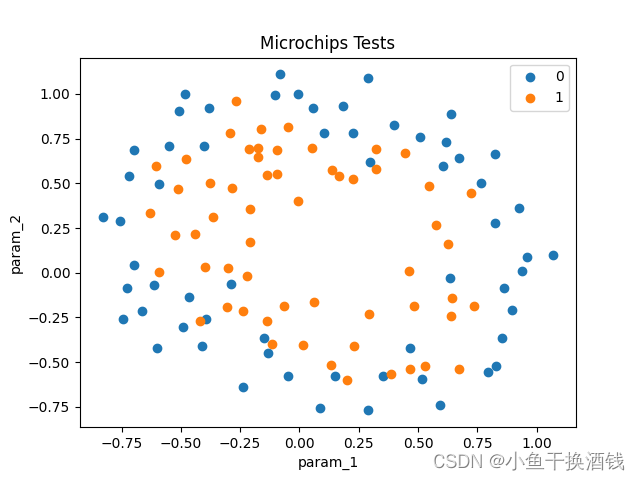1、介绍
目的:分类还是回归?经典的二分类算法!
机器学习算法选择:先逻辑回归再用复杂的,能简单还是用简单的
逻辑回归的决策边界:可以是非线性的
2、数学公式
2.1、Sigmoid 函数
公式:
自变量取值为任意实数,值域[0,1]

解释:将任意的输入映射到了[0,1]区间,我们在线性回归中可以得到一个预测值,再将该值映射到Sigmoid 函数中这样就完成了由值到概率的转换,也就是分类任务。
预测函数:
其中
2.2、分类任务
整合:
解释:对于二分类任务(0,1),整合后y取0只保留 ,y取1只保留

2.3、梯度下降求最优解
似然函数:
对数似然:
此时应用梯度上升求最大值,引入 转换为梯度下降任务
求导过程:
参数更新:
多分类的softmax:
3、代码实现
3.1、使用Scikit-learn库
直接使用Python的Scikit-learn库来实现逻辑回归算法
from sklearn.datasets import load_iris
from sklearn.linear_model import LogisticRegression
X, y = load_iris(return_X_y=True)
clf = LogisticRegression(random_state=0, solver='lbfgs', max_iter=10000,
multi_class='multinomial')
# 由于迭代更新次数太少,算法无法收敛,报错
clf.fit(X, y)
clf.predict(X[:2, :])
clf.predict_proba(X[:2, :])
result = clf.score(X, y)
print('Training Precision: {:5.4f}%'.format(result))3.2、自己手写逻辑回归算法
①数据样例(csv)
param_1,param_2,validity
0.051267,0.69956,1
-0.092742,0.68494,1
0.18376,0.93348,0
0.22408,0.77997,0
②主函数类
import numpy as np
import pandas as pd
import matplotlib.pyplot as plt
import math
from logistic_regression import LogisticRegression
# 非线性分界的逻辑回归
"""数据格式
param_1,param_2,validity
0.051267,0.69956,1
-0.092742,0.68494,1
0.18376,0.93348,0
0.22408,0.77997,0
"""
data = pd.read_csv('../data/microchips-tests.csv')
# 类别标签
validities = [0, 1]
# 选择两个特征
x_axis = 'param_1'
y_axis = 'param_2'
# 散点图
for validity in validities:
plt.scatter(
data[x_axis][data['validity'] == validity],
data[y_axis][data['validity'] == validity],
label=validity
)
plt.xlabel(x_axis)
plt.ylabel(y_axis)
plt.title('Microchips Tests')
# 图例
plt.legend()
plt.show()
# 行数
num_examples = data.shape[0]
x_train = data[[x_axis, y_axis]].values.reshape((num_examples, 2))
y_train = data['validity'].values.reshape((num_examples, 1))
# 训练参数
max_iterations = 100000
regularization_param = 0
polynomial_degree = 5
sinusoid_degree = 0
# 逻辑回归
logistic_regression = LogisticRegression(x_train, y_train, polynomial_degree)
# 训练
(thetas, costs) = logistic_regression.train(max_iterations)
columns = []
for theta_index in range(0, thetas.shape[1]):
columns.append('Theta ' + str(theta_index));
# 训练结果
labels = logistic_regression.unique_labels
plt.plot(range(len(costs[0])), costs[0], label=labels[0])
plt.plot(range(len(costs[1])), costs[1], label=labels[1])
plt.xlabel('Gradient Steps')
plt.ylabel('Cost')
plt.legend()
plt.show()
# 预测
y_train_predictions = logistic_regression.predict(x_train)
# 准确率
precision = np.sum(y_train_predictions == y_train) / y_train.shape[0] * 100
print('Training Precision: {:5.4f}%'.format(precision))
num_examples = x_train.shape[0]
samples = 150
x_min = np.min(x_train[:, 0])
x_max = np.max(x_train[:, 0])
y_min = np.min(x_train[:, 1])
y_max = np.max(x_train[:, 1])
X = np.linspace(x_min, x_max, samples)
Y = np.linspace(y_min, y_max, samples)
Z = np.zeros((samples, samples))
# 结果展示
for x_index, x in enumerate(X):
for y_index, y in enumerate(Y):
data = np.array([[x, y]])
Z[x_index][y_index] = logistic_regression.predict(data)[0][0]
positives = (y_train == 1).flatten()
negatives = (y_train == 0).flatten()
plt.scatter(x_train[negatives, 0], x_train[negatives, 1], label='0')
plt.scatter(x_train[positives, 0], x_train[positives, 1], label='1')
# 画等高线
plt.contour(X, Y, Z)
plt.xlabel('param_1')
plt.ylabel('param_2')
plt.title('Microchips Tests')
plt.legend()
plt.show()③逻辑回归类logistic_regression.py
import numpy as np
from scipy.optimize import minimize
from utils.features import prepare_for_training
from utils.hypothesis import sigmoid
class LogisticRegression:
def __init__(self, data, labels, polynomial_degree=0, normalize_data=False):
"""
1.对数据进行预处理操作
2.先得到所有的特征个数
3.初始化参数矩阵
"""
(data_processed,
features_mean,
features_deviation) = prepare_for_training(data, polynomial_degree, normalize_data=False)
self.data = data_processed
self.labels = labels
# 对于一维数组(元组)或列表,unique函数去除其中重复的元素,并按元素由小到大的顺序返回一个新的无重复元素列表
self.unique_labels = np.unique(labels)
self.features_mean = features_mean
self.features_deviation = features_deviation
self.polynomial_degree = polynomial_degree
self.normalize_data = normalize_data
num_features = self.data.shape[1]
num_unique_labels = np.unique(labels).shape[0]
self.theta = np.zeros((num_unique_labels, num_features))
def train(self, max_iterations=1000):
cost_histories = []
# 列数
num_features = self.data.shape[1]
# enumerate多用于在for循环中得到计数,利用它可以同时获得索引和值
for label_index, unique_label in enumerate(self.unique_labels):
current_initial_theta = np.copy(self.theta[label_index].reshape(num_features, 1))
current_lables = (self.labels == unique_label).astype(float)
(current_theta, cost_history) = LogisticRegression.gradient_descent(self.data, current_lables,
current_initial_theta, max_iterations)
self.theta[label_index] = current_theta.T
cost_histories.append(cost_history)
return self.theta, cost_histories
@staticmethod
def gradient_descent(data, labels, current_initial_theta, max_iterations):
cost_history = []
num_features = data.shape[1]
# scipy.optimize.minimize(fun, x0, method=None, bounds=None, constraints=(), ...)
# fun:目标函数,它的参数是待优化的参数向量。
# x0:优化变量的初始向量。只能传数组
# method:优化算法,包括BFGS、CG、L-BFGS-B等。
# bounds:定义优化变量的边界。
# constraints:定义优化变量的约束条件。
result = minimize(
# 要优化的目标:
# lambda current_theta:LogisticRegression.cost_function(data,labels,current_initial_theta.reshape(num_features,1)),
lambda current_theta: LogisticRegression.cost_function(data, labels,
current_theta.reshape(num_features, 1)),
# 初始化的权重参数
current_initial_theta.flatten(),
# 选择优化策略
method='CG',
# 梯度下降迭代计算公式
# jac = lambda current_theta:LogisticRegression.gradient_step(data,labels,current_initial_theta.reshape(num_features,1)),
jac=lambda current_theta: LogisticRegression.gradient_step(data, labels,
current_theta.reshape(num_features, 1)),
# 记录结果
callback=lambda current_theta: cost_history.append(
LogisticRegression.cost_function(data, labels, current_theta.reshape((num_features, 1)))),
# 迭代次数
options={'maxiter': max_iterations}
)
if not result.success:
raise ArithmeticError('Can not minimize cost function' + result.message)
optimized_theta = result.x.reshape(num_features, 1)
return optimized_theta, cost_history
@staticmethod
def cost_function(data, labels, theat):
num_examples = data.shape[0]
predictions = LogisticRegression.hypothesis(data, theat)
y_is_set_cost = np.dot(labels[labels == 1].T, np.log(predictions[labels == 1]))
y_is_not_set_cost = np.dot(1 - labels[labels == 0].T, np.log(1 - predictions[labels == 0]))
cost = (-1 / num_examples) * (y_is_set_cost + y_is_not_set_cost)
return cost
@staticmethod
def hypothesis(data, theat):
predictions = sigmoid(np.dot(data, theat))
return predictions
@staticmethod
def gradient_step(data, labels, theta):
num_examples = labels.shape[0]
predictions = LogisticRegression.hypothesis(data, theta)
label_diff = predictions - labels
gradients = (1 / num_examples) * np.dot(data.T, label_diff)
# flatten()是对多维数据的降维函数。
return gradients.T.flatten()
def predict(self, data):
num_examples = data.shape[0]
data_processed = prepare_for_training(data, self.polynomial_degree, self.normalize_data)[0]
# 这边得到的是[(结果是0的概率,结果是1的概率)],所以才在下面取概率较大的值为预测结果
prob = LogisticRegression.hypothesis(data_processed, self.theta.T)
# 较大的数在第几列
max_prob_index = np.argmax(prob, axis=1)
class_prediction = np.empty(max_prob_index.shape, dtype=object)
for index, label in enumerate(self.unique_labels):
class_prediction[max_prob_index == index] = label
return class_prediction.reshape((num_examples, 1))
④初始化数据normalize.py
这里并没有用到,略。
⑤数据处理prepare_for_training.py
"""Prepares the dataset for training"""
import numpy as np
# . 表示导入当前文件夹下的包
from .normalize import normalize
from .generate_sinusoids import generate_sinusoids
from .generate_polynomials import generate_polynomials
def prepare_for_training(data, polynomial_degree=0, normalize_data=True):
# 计算样本总数
num_examples = data.shape[0]
data_processed = np.copy(data)
# 预处理
features_mean = 0
features_deviation = 0
data_normalized = data_processed
if normalize_data:
(
data_normalized,
features_mean,
features_deviation
) = normalize(data_processed)
data_processed = data_normalized
# 特征变换polynomial
if polynomial_degree > 0:
polynomials = generate_polynomials(data_normalized, polynomial_degree, normalize_data)
data_processed = np.concatenate((data_processed, polynomials), axis=1)
# 加一列1
# np.hstack:水平(按列顺序)把数组给堆叠起来,vstack()函数正好和它相反
data_processed = np.hstack((np.ones((num_examples, 1)), data_processed))
return data_processed, features_mean, features_deviation
⑥特征变换generate_polynomials.py
"""Add polynomial features to the features set"""
import numpy as np
from .normalize import normalize
def generate_polynomials(dataset, polynomial_degree, normalize_data=False):
"""变换方法:
x1, x2, x1^2, x2^2, x1*x2, x1*x2^2, etc.
"""
# 按行(竖向)将一个数组拆分为多个。返回的是一个数组,其中包含多个数组
features_split = np.array_split(dataset, 2, axis=1)
dataset_1 = features_split[0]
dataset_2 = features_split[1]
(num_examples_1, num_features_1) = dataset_1.shape
(num_examples_2, num_features_2) = dataset_2.shape
if num_examples_1 != num_examples_2:
raise ValueError('Can not generate polynomials for two sets with different number of rows')
if num_features_1 == 0 and num_features_2 == 0:
raise ValueError('Can not generate polynomials for two sets with no columns')
if num_features_1 == 0:
dataset_1 = dataset_2
elif num_features_2 == 0:
dataset_2 = dataset_1
num_features = num_features_1 if num_features_1 < num_examples_2 else num_features_2
# 获取二维数组的所有行和num_features数量的列
dataset_1 = dataset_1[:, :num_features]
dataset_2 = dataset_2[:, :num_features]
# 返回一个(num_examples_1, 0)维度的数值,里面的数据并不一定都为空
polynomials = np.empty((num_examples_1, 0))
for i in range(1, polynomial_degree + 1):
for j in range(i + 1):
polynomial_feature = (dataset_1 ** (i - j)) * (dataset_2 ** j)
# 语法:concatenate((a1, a2, …), axis=0)
# 说明:(a1, a2, …)为待拼接的数据,可以是一维,也可以是多维。
# axis决定着怎么将数据拼接:axis=0是将数据按列拼接(即竖着拼接);
# axis=1是将数据按行拼接(即横着拼接);
# axis=None则是先将数据拉成一维向量,再拼接。
polynomials = np.concatenate((polynomials, polynomial_feature), axis=1)
if normalize_data:
polynomials = normalize(polynomials)[0]
return polynomials
⑥运行结果
需要分类的数据

训练过程中的损失值

分类结果

4、总结
常用于二分类。
最后,觉得有帮助或者有点收获的话,帮忙点个赞吧!





















 1226
1226











 被折叠的 条评论
为什么被折叠?
被折叠的 条评论
为什么被折叠?








